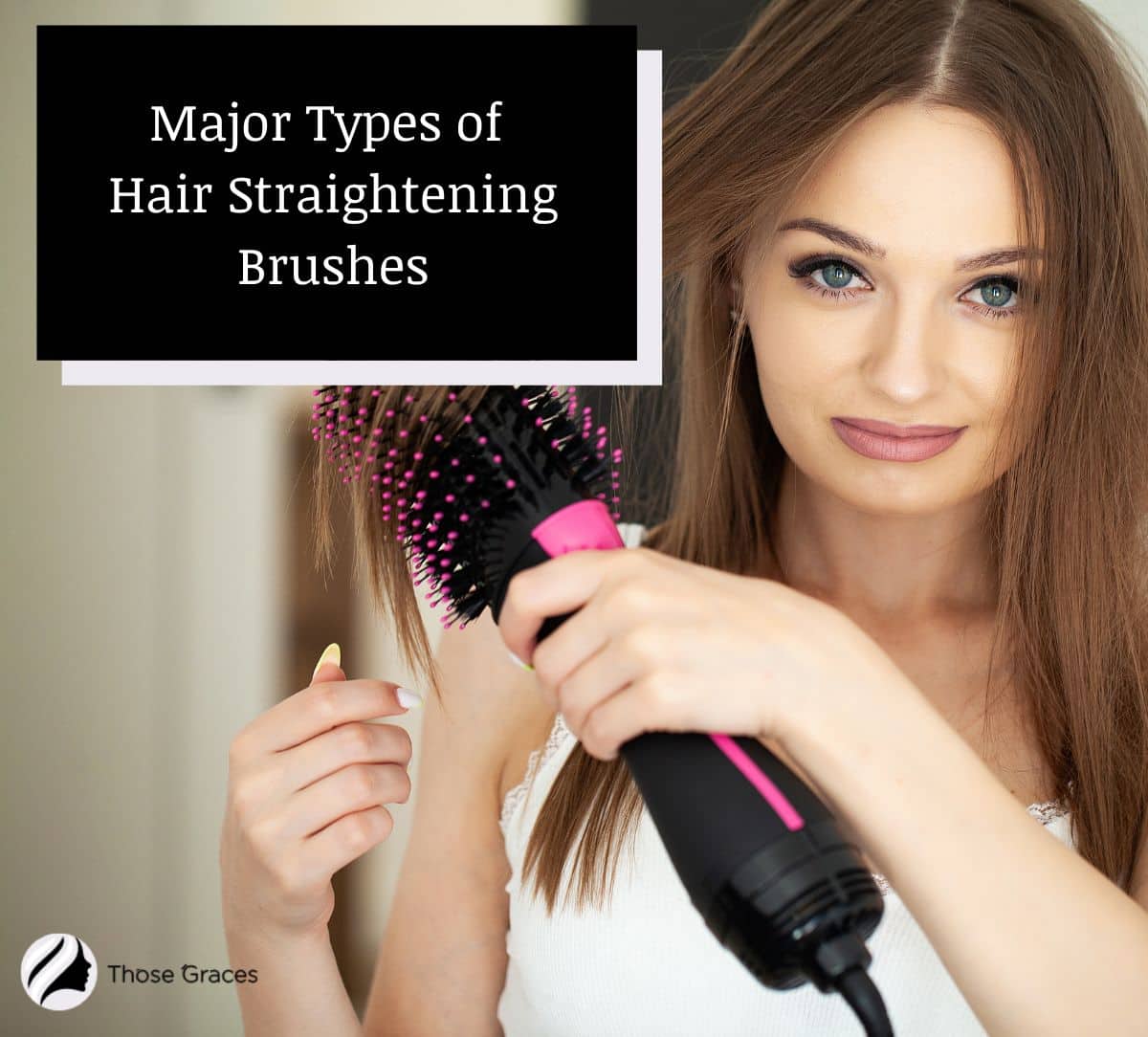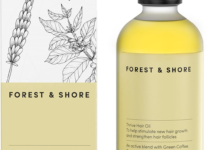Want to buy a straightening brush but do not know which one is going to be suitable for you and your hair routine?
I’ve got you covered! I’ve compiled a comprehensive list of straightening brushes best suited for every hair type.
By considering factors such as hair texture, length, and type, you can find the right product using the correct temperature that will help you achieve an optimal straightening outcome.
So, take a look at our list and choose the perfect straightening brush for your hair!
Key Takeaways
- Know the best type of styling tool brushes to use for your length of hair and its drawbacks.
- Soft bristles work best for fine, thin, or wet hair, while stiffer bristles are better for coarse or thick hair.
- It’s worth considering using a hair straightening brush even if you have moderately straight hair. However, make sure to choose a heat-resistant brush made of ceramic or tourmaline for safe use during blow-drying.
Based on the Actual Shapes of the Brushes
1. Regular Brush Shaped Straightening Brush
Straightening brushes are designed to look like regular brushes[1] but come with a temperature and heat setting.
To use them, simply straighten your hair with the brush as you would normally brush. It’s a straightforward process that can give you great smooth hair!
When using this type of straightening brush, it’s important to note that they should not be used like flat irons.
You may need to brush a portion of your hair two or three times to achieve the desired level of straightness, or you can brush bit by bit to ensure each section is straightened properly.
2. Flat Iron Shaped Straightening Brush
These straightening brushes look like a straightener or flat irons.
To use this device, simply press the two plates together and place your hair in between them.
Depending on Hair Types and Lengths
Straightening your hair is a simple process, but it’s important to choose the right straightening brush for your hair length (short, medium, long).
There are two shapes of straightening brushes available: one is designed for short to medium-length hair, while the other is ideal for long hair.
Big brushes are recommended for long hair.
Handy brushes are recommended for people who have medium and short hair.
Besides these two basic shapes, there are 2 particular shapes of straightening brushes.
If you’re looking to elevate your hair care regimen, dive into our articles on how to clean hair straightening brush and our top picks for the best straightener for keratin treatment.
3. Circular or Round Straightening Brush
This type of brush is very good for people with long hair as a larger diameter will give a soft blow-dry and a perfect straightening.
This particular brush has a larger surface area compared to flat or paddle brushes. This allows it to cover more of your hair, providing additional benefits for those with long hair.
Medium and short-haired people often struggle to straighten their hair with circular or round-shaped brushes because the hair can’t wrap around the brush to create enough tension[2] to smooth, straighten, or style.
4. Flat Brush or Paddle Straightening Brush
A smaller surface area allows for better control and easier manipulation of the hair. So, if you’re struggling to straighten your hair with a circular or round-shaped brush, try switching to a smaller brush to see if it makes a difference.
On the other hand, if you have long hair or are not comfortable straightening a large portion of your hair at once, consider using smaller brushes for better control and precision. This will make the process easier and less overwhelming.
Though paddle brushes can be used in long hair, it can take too much time to straighten and style the hair.
Check out this video to learn how to use a straightening brush:
According to The Bristles
There are 3 types of straightening brushes based on the type of bristle used.
5. Boar Bristles
The most common bristle among all three types of bristles is the boar bristle[3].
This type of bristle is used by most hair experts because of the tension [3] it creates to set and hold curls and style as well as distribute natural scalp oil through the hair.
Using a boar bristle brush can significantly enhance the texture of your hair, minimize frizz, and promote healthy hair by stimulating your scalp.
It helps to increase the blood flow in your scalp and ultimately helps to repair hair cuticles.
100% pure boar bristle brush can be expensive[4].
6. Ball-tipped Bristles
Some hair types are more likely to tangle than others. To avoid any potential tangling, snagging, or hitching while straightening with a brush, it’s best to use ball-tipped bristles.
Using a brush with ball-tipped bristles can make all the difference when straightening your hair.
The nylon fibers and ball-tipped bristles work together to effortlessly glide through hair and achieve a smooth and polished look without any fuss or frustration.
Ball-tipped bristles can help exfoliate dead skin cells, stimulating more blood flow and promoting healthier hair growth.
A detangling brush with ball-tipped bristles[5] works great for wet or dry hair, wavy and curly hair, as it prevents scratching and discomfort.
Sometimes, ball-tipped bristles can have trouble penetrating the thickness of the hair, but a firmer brush can help with that.
It’s worth experimenting with different brushes to find what works best for your hair type.
7. Nylon Bristles
For those with a sensitive scalp, nylon bristles[4] may be a better option as they are gentler on the hair and scalp.
Thick hair can be particularly challenging to manage, but a brush with nylon bristles is a great choice as it can easily penetrate the hair and help straighten it out.
For easy detangling, use a nylon brush with widely spaced bristles. It glides through hair without causing tension or friction, making it smoother.
For optimal hair care during blow-drying, it is recommended to utilize a brush that is heat-resistant.
It is strongly advised to avoid using nylon brushes, as they have a tendency to melt and harm your hair.
Pro tips: Besides these tricks of choosing types of bristles according to hair and scalp texture and condition, there are some common rules on choosing bristles for straightening brushes.
Make sure to choose a hair straightening brush that has bristles firmly attached to the base to ensure its longevity.
You want to ensure that the bristles are not too stiff or harsh on your scalp, as this could be damaging to your hair.
A good way to test if the brush is gentle enough is to try it out on the back of your hands first.
This will allow you to judge the stiffness of the bristles and make an informed decision about which brush to purchase.
Here’s another cool review:
According to Plate Materials
The plate materials of hairbrushes play a very vital role in the process of straightening. It’s important to do your research and choose the one that’s best for your hair type.
8. Ceramic & Tourmaline Straightening Brushes
Ceramic plates and tourmaline hair brushes[6] are the safest options for your hair. This is because the heated plates of these brushes are designed to distribute heat evenly across their surfaces.
This ensures that there are no hot spots that can cause localized overheating and potential hair damage.
A ceramic-coated brush is a great option because it can transfer heat to the hair during styling.
It can quickly regain heat, ensuring that the optimum temperature is maintained throughout the styling process. This helps to prevent any heat damage to the hair, making it a safe option for your hair care routine.
Ceramic and Tourmaline straightening brushes emit negative ions that counteract positive ions in hair, eliminating static electricity and flyaways.
These negative ions can also repair and seal damaged hair cuticles, locking in the hair’s natural oils for a smooth, shiny, healthy-looking finish.
We suggest buying a brush with digital temperature control, a 360-degree swivel power cord, and an auto shuff-off feature to help with faster and more comfortable styling.
Ceramic – If you have dry, thin, fine, or damaged hair, that needs some extra love and protection, this is the best choice.
Tourmaline – if you want to use the device daily and you have normal to coarse hair, this will be the perfect one for you!
For those with very thick and kinky hair, it may be challenging to straighten hair with ceramic or titanium brushes alone.
These types of brushes may not be able to apply enough heat to effectively straighten the thicker hair or may take a long time to do so.
9. Titanium & Nano Titanium Straightening Brushes
Titanium straightening brushes can handle high heat levels, making these brushes suitable for thick and coarse hair types that require higher temperatures for effective straightening.
The smooth surface of titanium can provide a sleek and smooth glide through your hair, minimizing tugging and pulling.
Nano Titanium brushes can provide an exceptionally smooth finish, as the smaller particles offer a finer surface texture that can enhance the glide through your hair.
The high heat and efficient straightening might not be suitable for fine or damaged hair types, as they could lead to over-straightening and damage.
FAQs
What type of brush is best for straightening hair?
Which straightening brush is best for curly and frizzy hair
Does a straightening brush damage hair?
Last Words
People have varying hair types and lengths, and the same goes for the types of straightening brushes.
We have compiled a list of the most common types of brushes. Use these brushes based on your hair condition, texture, and length, and also ask a hair care expert when in doubt.
By now, you should be familiar with all the types of straightening brushes and their respective pros and cons.
Sources:
[2] Designing a better hair straightener: https://dspace.mit.edu/handle/1721.1/32779
[3] Boar Hair VS Nylon Bristles: What’s the Difference?: https://www.spornette.com/boar-hair-vs-nylon-bristles/
[4] HAIR CARE ON A BUDGET: https://www.proquest.com/openview/324f6ee0629c03ec86773a3d83fc8cb4/1?pq-origsite=gscholar&cbl=30763
[5] Brushing hair unlocking the secrets of healthy: https://hairbrushy.com/brushing-hair-unlocking-the-secrets-of-healthy-hair/#Wavy_Hair
[6] Understanding Ceramic Hair Brushes:https://www.hotairbrushreviews.com/understanding-ceramic-hair-brushes/



